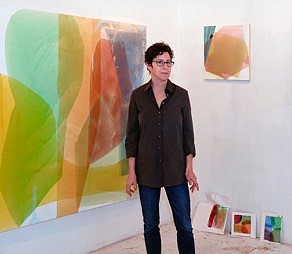
JILL NATHANSON POURS SEDUCTIVE POLYMERS
March 16, 2016 - Jamie de Simone for MoCA Jacksonville
“How do you find the art?”
At MOCA Jacksonville, our internal punchy response is “curatorial magic.” Part fib, part wishful thinking, I am grateful to have a network of trusted colleagues, who are always willing to lend an ear about a project, offer insight, or gush about an artist's work. In August, esteemed scholar Karen Wilkin and I drove from the Colby College Museum of Art to Portland, Maine, where we would spend the next three days meeting with our counterparts at the Portland Museum of Art about an upcoming Hans Hofmann project. However, my relationship with Karen dates back to before my time at MOCA Jacksonville, and should I get a free moment to discuss an idea with her, I never let an opportunity pass. That's how I became acquainted with the work of Jill Nathanson—as a result of a casual summer drive.
Nathanson constructs color fields of acrylic polymer gels. I immediately Googled images on my iPhone after my conversation. Interesting was my immediate reaction, but “interesting” is my “go-to” word, my word when I don't yet know how to describe an object, but think something deeper, richer is occurring. Nathanson's work was, and is, interesting, but I couldn't come to describe the “why” until I saw the paintings firsthand.
After leaving Maine on a search for the first Stein Prize recipient, I quickly set up an appointment to meet Nathanson at the Berry Campbell Gallery in New York City, where we would spend more than two hours gushing about color energies, dramatic intervals, tensions between light and space, and comparisons to music. (Many of her titles reference harmonies or instruments.) I scribbled in my notebook:
Think Jules Olitski and Morris Louis
How lines edge her surfaces—find that Olitski quote!
Research Golden Artists Colors
Material vs. immaterial
States of flow
Kandinsky?
Depth
Better, stronger in person
(My apologies about this elementary stream of consciousness, Jill!)
I embarrassingly shot iPhone photos of her work like a pushy, proud mother who takes photos of her children on the first day of school—“smile.” I probably saw twenty paintings that day. The majority of Nathanson's panels are square, about 54 x 54 or 60 x 60 inches upon which she pours hand-mixed colors of acrylic paint and polymer to produce a gentle yet seductive surface. The use of gels provides a translucent aura, where the color “desires,” as she refers to them, overlap and bleed onto one another. The painter is consistently exploring and exposing color relationships and qualities of experience.
Perhaps Wilkin and I should add “magic” as a special skill set on our CVs.
I give special thanks to Wilkin and, of course, Nathanson, who agreed to participate in the upcoming exhibition Confronting the Canvas: Women of Abstraction. If you happen to be in New York this May, you can see some of her paintings in a new exhibition at Berry Campbell Gallery.
Back to News
